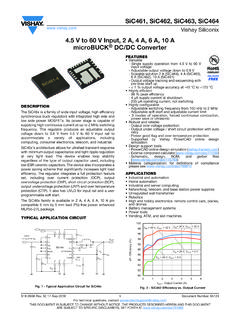Transcription of Architecture of a Database System
1 Foundations and TrendsR inDatabasesVol. 1, No. 2 (2007) 141 259c 2007 J. M. Hellerstein, M. Stonebrakerand J. HamiltonDOI: of a Database SystemJoseph M. Hellerstein1, Michael Stonebraker2and James Hamilton31 University of California, Berkeley, USA, Institute of Technology, USA3 Microsoft Research, USAA bstractDatabase Management Systems (DBMSs) are a ubiquitous and criticalcomponent of modern computing , and the result of decades of researchand development in both academia and industry. Historically, DBMS swere among the earliest multi-user server systems to be developed, andthus pioneered many systems design techniques for scalability and relia-bility now in use in many other contexts.
2 While many of the algorithmsand abstractions used by a DBMS are textbook material, there has beenrelatively sparse coverage in the literature of the systems design issuesthat make a DBMS work. This paper presents an architectural dis-cussion of DBMS design principles, including process models, parallelarchitecture, storage System design, transaction System implementa-tion, query processor and optimizer architectures, and typical sharedcomponents and utilities. Successful commercial and open-source sys-tems are used as points of reference, particularly when multiple alter-native designs have been adopted by different Management Systems (DBMSs) are complex, mission-criticalsoftware systems.
3 Today s DBMSs embody decades of academicand industrial research and intense corporate software systems were among the earliest widely deployed online serversystems and, as such, have pioneered design solutions spanning not onlydata management, but also applications , operating systems, and net-worked services. The early DBMSs are among the most influential soft -ware systems in computer science, and the ideas and implementationissues pioneered for DBMSs are widely copied and a number of reasons, the lessons of Database systems architec-ture are not as broadly known as they should be.
4 First, the applieddatabase systems community is fairly small. Since market forces onlysupport a few competitors at the high end, only a handful of successfulDBMS implementations exist. The community of people involved indesigning and implementing Database systems is tight: many attendedthe same schools, worked on the same influential research projects, andcollaborated on the same commercial products. Second, academic treat-ment of Database systems often ignores architectural issues. Textbookpresentations of Database systems traditionally focus on Relational Systems: The Life of a Query143and theoretical issues which are natural to teach, study, and test without a holistic discussion of System Architecture in full implementa-tions.
5 In sum, much conventional wisdom about how to build databasesystems is available, but little of it has been written down or commu-nicated this paper, we attempt to capture the main architectural aspectsof modern Database systems, with a discussion of advanced topics. Someof these appear in the literature, and we provide references where appro-priate. Other issues are buried in product manuals, and some are simplypart of the oral tradition of the community. Where applicable, we usecommercial and open-source systems as examples of the various archi-tectural forms discussed. Space prevents, however, the enumeration ofthe exceptions and finer nuances that have found their way into thesemulti-million line code bases, most of which are well over a decade goal here is to focus on overall System design and stress issuesnot typically discussed in textbooks, providing useful context for morewidely known algorithms and concepts.
6 We assume that the readeris familiar with textbook Database systems material ( , [72] or [83])and with the basic facilities of modern operating systems such as UNIX,Linux, or Windows. After introducing the high-level Architecture of aDBMS in the next section, we provide a number of references to back-ground reading on each of the components in Section Relational Systems: The Life of a QueryThe most mature and widely used Database systems in productiontoday are relational Database management systems (RDBMSs). Thesesystems can be found at the core of much of the world s applicationinfrastructure including e-commerce, medical records, billing, humanresources, payroll, customer relationship management and supply chainmanagement, to name a few.
7 The advent of web-based commerce andcommunity-oriented sites has only increased the volume and breadth oftheir use. Relational systems serve as the repositories of record behindnearly all online transactions and most online content management sys-tems (blogs, wikis, social networks, and the like). In addition to beingimportant software infrastructure, relational Database systems serve as144 IntroductionFig. Main components of a well-understood point of reference for new extensions and revolutionsin Database systems that may arise in the future. As a result, we focuson relational Database systems throughout this heart, a typical RDBMS has five main components, as illustratedin Figure As an introduction to each of these components and theway they fit together, we step through the life of a query in a databasesystem.
8 This also serves as an overview of the remaining sections of a simple but typical Database interaction at an airport, inwhich a gate agent clicks on a form to request the passenger list for aflight. This button click results in a single-query transaction that worksroughly as follows:1. The personal computer at the airport gate (the client ) callsan API that in turn communicates over a network to estab-lish a connection with theClient Communications Managerof a DBMS (top of Figure ). In some cases, this Relational Systems: The Life of a Query145is established between the client and the Database serverdirectly, , via the ODBC or JDBC connectivity arrangement is termed a two-tier or client-server System .
9 In other cases, the client may communicate witha middle-tier server (a web server, transaction process-ing monitor, or the like), which in turn uses a protocol toproxy the communication between the client and the is usually called a three-tier System . In many web-based scenarios there is yet another application server tierbetween the web server and the DBMS, resulting in fourtiers. Given these various options, a typical DBMS needsto be compatible with many different connectivity protocolsused by various client drivers and middleware systems. Atbase, however, the responsibility of the DBMS client com-munications manager in all these protocols is roughly thesame: to establish and remember the connection state forthe caller (be it a client or a middleware server), to respondto SQL commands from the caller, and to return both dataand control messages (result codes, errors, etc.)
10 As appro-priate. In our simple example, the communications managerwould establish the security credentials of the client, set upstate to remember the details of the new connection and thecurrent SQL command across calls, and forward the client sfirst request deeper into the DBMS to be Upon receiving the client s first SQL command, the DBMS must assign a thread of computation to the command. Itmust also make sure that the thread s data and control out-puts are connected via the communications manager to theclient. These tasks are the job of the DBMSP rocess Man-ager(left side of Figure ).



